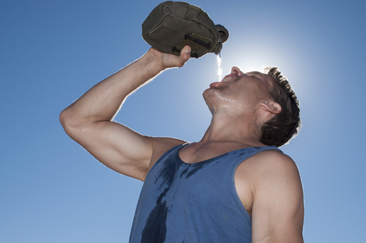
A recent article in the American Journal of Orthopedics analyzes the impact of exertional heat stroke (EHS) on American football and provides critical information for team physicians on prevention, diagnosis, management, and return-to-play issues. Outsourcing medical transcription is a great option to document such health events as well as for injury/illness tracking and clinical audits.
Heat strokes occur because of the body’s inability to cope with heat. Unlike standard heat stroke which typically affects sedentary older adults, exertional heat stroke (EHS) occurs in younger people and athletes who engage in strenuous physical activity for a prolonged period of time in hot weather. EHS is not always serious, but it can cause severe organ damage and lead to death if not recognized and treated promptly and properly.
During exercise, the body’s mechanisms regulate heat gain by increasing skin blood flow and sweating. However, this process can be affected by elevated environmental temperatures, increased humidity, and dehydration. Imbalances in thermoregulation can result in further complications and lead to EHI.
Football players face unique challenges that expose them to higher risks of exertional heat injury (EHI). According to the above-mentioned report, about 9000 cases of EHI occur every year across all high school sports, but studies show that EHI occurs in football 11.4 times more often than in all other high school sports combined. The main points of the study are as follows:
- EHS is preventable and team physicians should pay close attention to mitigating risk factors prior to the onset of preseason practice.
- Rapid diagnosis and treatment of EHS is crucial as any delay in the treatment can dramatically increase the risks of morbidity and mortality.
- EHS is diagnosed by an elevated rectal temperature ≥40°C (104°F) and associated central nervous system (CNS) dysfunction.
- Symptoms indicative of EHS include: CNS dysfunction (disorientation, confusion, dizziness, irritability, headache, delirium, collapse, seizures), and heat exhaustion, (fatigue, tachycardia, vomiting, diarrhea, hypotension).
- Treatment should focus on cooling the whole body rapidly at the first sign of heat illness, and to bring down rectal temperature to <38.9°C within 30 minutes of the onset of the heat stroke.
- Based on the physician’s assessment, intravenous fluid resuscitation should be started.
- Once the optimal rectal temperature is reached, the cooling process should be stopped and the individual should be transported to a hospital for further treatment, if necessary.
- The decisions surrounding return to play are highly individualized as recovery from heat injury depends on the duration of internal body temperature elevation above the critical level.
Football team physicians should be alert to the early symptoms of heat illnesses and prepared implement timely interventions to prevent progression to EHS. They should also educate coaches and players about EHI prevention practices and policies. As EHS is a unique life-threatening condition, the authors recommend that it is best to treat the patient on the sidelines before transport. They also stress that team physicians should develop a site-specific emergency action plan to address potential EHS events.
Proper clinical communication and record-keeping strategies are key elements in athlete health management. Professional companies provide accurate and timely electronic health record integrated medical transcription services to meet the needs of these providers. Their documentation solutions allow the physicians and their medical team rapid and remote access to comprehensive health data from any location. Such support would help them focus on their core tasks of developing and implementing comprehensive prevention strategies and emergency action plans to minimize athletes’ risk of adverse outcomes from an EHI.


